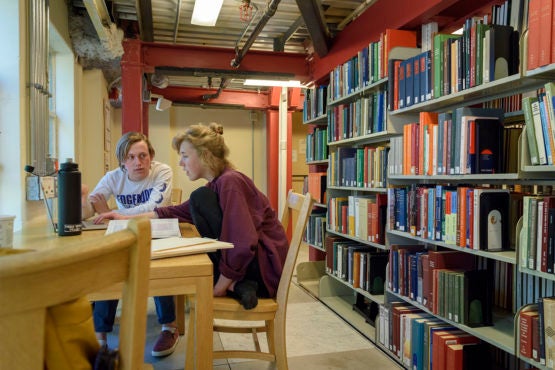Democratizing access to resources for Stanford researchers
Stanford Vice Provost and Dean of Research Kathryn Moler wants all research resources to be as readily available as books in a library. This model would enable faculty and students to pursue the most innovative research in flexible, collaborative teams.
With the growing cost of research equipment and a trend toward larger, more fluid interdisciplinary teams, the university’s Long-Range Vision calls for an expansion of shared resources and facilities to enable research of the future, including equipment shared amongst diverse groups, expertise to support new research directions and funding for faculty creating new platforms.
Stanford Vice Provost and Dean of Research Kathryn Moler described this model as similar to a library, where anyone can check out what they need to enable research.
“Imagine if all faculty members and students had the resources they need to share the latest data sets, methods and instruments,” Moler said. “People have called it an increased democratization of access to resources.”
The idea might seem familiar at Stanford, where shared resources, facilities and funding through the institutes and other academic units have created communities of researchers from different schools and departments who share knowledge, expertise, data, seed funding, fellowship funding and other resources as they address problems within a topic area, like the environment, the economy or neuroscience. The strategic platforms build on these successes and extend the benefits for individual researchers and teams by structuring institute-like resources at all scales, regardless of topic.
“Stanford’s life sciences and policy institutes have really been at the vanguard of fostering interdisciplinary collaboration within their areas of focus, and now in this next phase we want to extend that to all faculty and students and all areas of scholarship,” said Moler, who is also a professor of physics and of applied physics in the School of Humanities and Sciences.
Strategic platforms throughout the university have not only supported innovative research but recently helped faculty pivot to study the novel coronavirus, Moler said. These resources include knowledge centers that house research equipment and provide expert assistance, seed grants and a lab space where investigators can work with SARS-CoV-2 – the virus that causes COVID-19.
Expanding the range of resources available will help make the university nimbler as future challenges arise, Moler said. It also makes economic sense at a time when any investment needs to support as many research and educational activities as possible.
Equipment, funding, expertise
The idea for the strategic platform approach arose in part out of faculty concerns over the cost of equipment and limited funding available for risky ideas. In some cases, faculty face a dilemma: they need preliminary data and access to specialty equipment in order to get funding, but don’t have the funding to gather the data or buy the equipment.

The Strategic Platforms would make all research resources as readily available as books in a library. (Image credit: L.A. Cicero)
Academic units including the life sciences institutes (Stanford Bio-X, Stanford ChEM-H and the Wu Tsai Neurosciences Institute) have helped overcome those barriers for researchers within their topic areas, by providing funding for novel research directions and placing expensive equipment in a shared facility staffed by people with appropriate expertise. Expanding access to state-of-the-art shared resources and research funding would upend this Catch-22 for all researchers regardless of subject area.
Putting equipment in shared spaces also takes pressure off individual faculty members, who would ordinarily be responsible for equipment maintenance, contracts and scheduling for collaborators. It also helps create a collaborative community of scholars who share research approaches, protocols and best practices.
The approach also benefits students, Moler said. “Students with bright, creative, roving minds who have access to tools and license to follow their curiosity, insights and passions tend to develop interdisciplinary talents, expertise and connections that enable them to innovate throughout their careers,” she said.
Over the past year, faculty-led teams developed recommendations for platforms including nanofacilities, imaging, data resources, and expanding Stanford’s existing network of makerspaces. Moler said that, like existing resources, she expects many of the new facilities would be shared with visitors from academia, national labs and industry, who bring expertise and new ideas that benefit both researchers and students.
In addition to jointly operating purchased equipment, the platforms could include technologies developed by Stanford faculty and students that aren’t ready for commercialization but could still benefit the community. Sharing those techniques along with training and opportunities for collaboration accelerates their impact on many fields. Moler likened this to the way Stanford Bio-X created space where Karl Deisseroth, professor of bioengineering and of psychiatry and behavioral sciences, could train researchers at Stanford and beyond in the new technique of optogenetics, greatly expanding its impact in scientific research.
“This makes a technique available to researchers as soon as it can be responsibly be made ready and I think that’s a really important part of the strategy,” Moler said.
Moler also envisions funding sources for students and faculty to support new capabilities or educational resources that benefit the entire research ecosystem.
Another gap identified by faculty is the need for expanded data resources and computation services to support the increasing reliance on data in all areas of research, including the humanities and social sciences. Moler proposes embedding those resources within appropriate units and hiring internal experts who can help researchers analyze, process, store and present data, and who can create data use agreements. This pool of expertise would prevent research groups from needing to seek out and negotiate those services individually.
Moler said Stanford already has lower barriers to collaboration than most universities, but this expanded access to equipment, funding and expertise would enhance connectivity across different academic enterprises.
“We need to make investments that benefit team science and people at every stage of their careers across many different disciplines,” she said.
